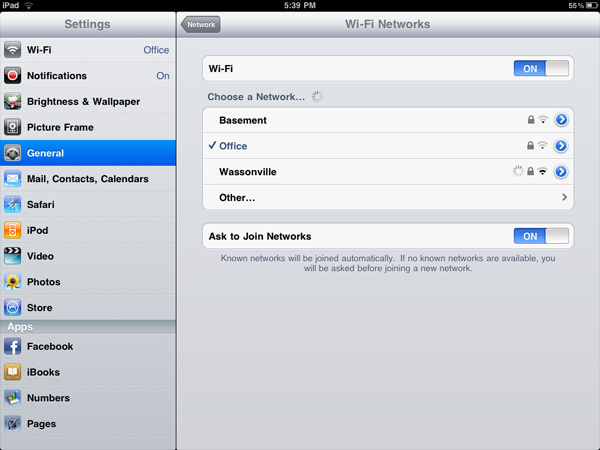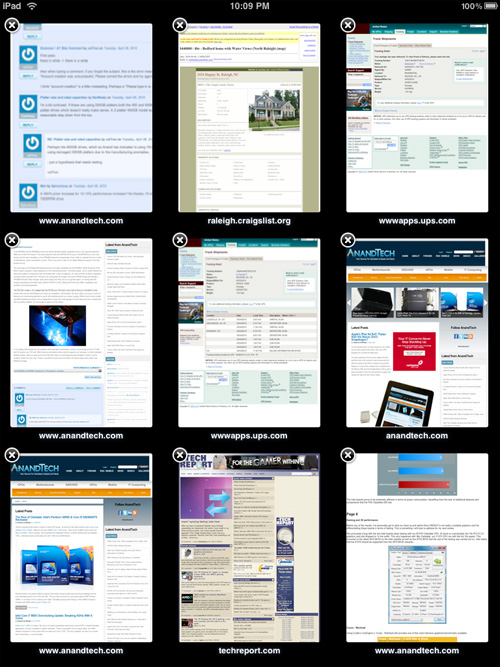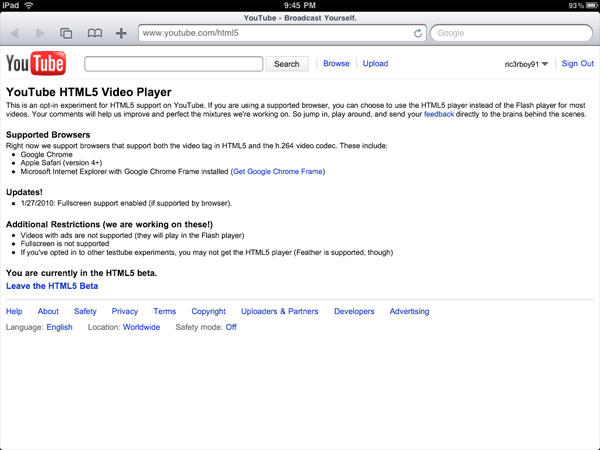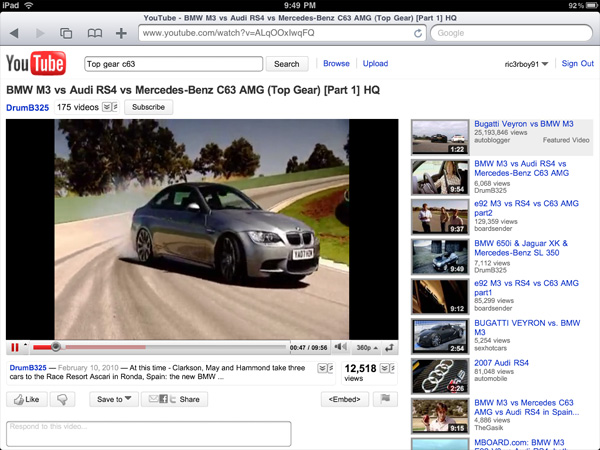Apple's iPad - The AnandTech Review
by Anand Lal Shimpi, Brian Klug & Vivek Gowri on April 7, 2010 9:39 PM EST- Posted in
- Smartphones
- Mac
- Apple
- iPad
- Mobile
WiFi
Many iPad users have been complaining about poor WiFi performance. What I have seen is the iPad doesn't seem to like to let go of a poorly performing access point in favor of another known access point with much better signal strength. Apple indicates that the iPad may not rejoin a known dual-band access point after coming out of sleep. I'm not sure whether my issue falls under Apple's KB article or not because the iPad will join my other networks, it just doesn't pick them as aggressively as I'd like.

Which one of these would you choose?
I've seen smartphones do this as well and it is a problem on my MacBook Pro. The more mobile the device however, the more annoying poorly calculated handoff timing is. Not to mention that because the iPad runs the same OS as the iPhone, there's no way to quickly switch between WiFi access points from the home screen.
The Killer App - Web Browsing
Reading web pages on the iPad is great. The 4:3 aspect ratio gives you a nice column for text heavy websites and landscape mode works well for wider layouts. It's a great tool for browsing the web and sharing what you find with others sitting around you. I can even see it being perfect for web designers working on building websites together.

Navigation is wonderful thanks to the touch screen and web sites look gorgeous thanks to the pricey LCD. Scrolling is super smooth, and it’s so much more comfortable reading articles away from a desk or without the added bulk of a laptop. It’s relaxed computing.
I'm a bit torn on this one because although I love browsing on the iPad, I'm not a fan of using it to write lengthy responses to comments on AnandTech. Quick responses are fine, it’s the longer ones that I don’t like drafting on the iPad. What I usually end up doing is reading the comments on the iPad and responding to them from my desktop. Did I mention that the iPad was a luxury?

Tabbed browsing isn't supported but you can have multiple browsers and slowly switch between them
The difference in screen size and resolution between the iPad and iPhone really makes itself felt inside Safari. Where in the iPhone you end up in stripped down mobile versions of websites, the iPad is capable of displaying a regular webpage in full-fledged glory. And because of the processing horsepower in the A4 SoC, the iPad has no problems rendering these full pages (more on this later). Part of the reason is because processor-heavy Flash objects are skipped over entirely, but doing so keeps the browsing experience fluid, which is arguably more important in a device like this.
So how does the iPad deal with content-rich sites that depend on mixed media elements? It's mixed, but overall pretty well. Pages like the new AnandTech, Autoblog, and Engadget are perfect, with the exception of the blank space wherever there should be embedded Flash objects. (There's no more blue Lego of Flash as there is on the iPhone to let you know when you're missing out.) Things get more interesting when you start hitting HTML5 video-enabled websites.

One of the first things I tried was the YouTube HTML5 beta. Yes, I know there's a YouTube app, but it's always nice to know that you can get the desktop version of YouTube working in Safari. Except, it isn't quite that simple. Reading through the HTML5 Beta page, there's one line that makes all the difference: "Videos with ads are not supported (they will play in the Flash player)." Which essentially means, if you ever want to watch an official music video or movie trailer (almost all of them have ads), you're hosed. Stick to the more off the road stuff (old Top Gear clips and various Indian music videos are good bets) and you should be okay, but it remains kind of annoying to go to a video page and be greeted with an empty hole where the video should have been. I'm hoping that Google will recognize the potential of a browser-based YouTube and disable ads when viewing on the iPad, but that remains to be seen.

Sites built around HTML5 video (or recently converted to HTML5 video in the run up to the iPad launch) work as advertised. ESPN has made the switch, and I was impressed at how seamlessly the experience translated from a normal computer. The New York Times also uses HTML5 video on their website, and it behaves just as it would in a desktop browser.

As far as social networking and communication websites go, the classic versions of Facebook, Twitter, and the Google web app suite all work to varying degrees. Twitter has a fairly simple desktop interface which translates over to the iPad flawlessly. Facebook functions well, though some of the buttons are a bit small. Also, the photo uploader doesn't work on the iPad, and while Facebook Chat does work, it remains fixed on the page, even if you scroll down. Nonetheless, it's far better than the touch optimized version of Facebook on the iPhone. It will be interesting to see how the Facebook developers utilize the extra screen space when creating the Facebook for iPad application. If it behaves like a slightly more touch optimized version of the full Facebook (instead of the icon-based iPhone app), it has the potential to be very user-friendly.

Google is another story entirely. For Gmail users, the iPad-optimized version of Gmail is awesome - you get the same dual pane message view like the Mail app, but with Gmail's signature threaded messaging included.

Google Docs is also optimized for iPad viewing. Note - viewing, not editing. There is no way as of yet to open a document in the desktop view, so it isn't possible to edit or create a new document. Highly disappointing, since full Google Docs compatibility would have been a killer feature on the iPad. If Google sees fit to rectify this problem by adding a mode to open a document in desktop view (and thus retain the ability to edit a document), it will be great. Google Talk Mobile is the same as on iPhone, except bigger, so you end up with a lot of wasted screen space. iGoogle Mobile is again the same as on iPhone, except larger, but switching to the desktop version of iGoogle fixes that problem. Some of the more advanced Google gadgets don't work, but the Gmail and RSS feeds work, as does the Weather gadget. The Google Chat sidebar makes it tempting to use the IM feature, but the experience is sadly broken. The chat windows are, like Facebook Chat, fixed on the page, and the text sometimes gets cut off on the edge of the screen. It's not enjoyable to use, but it will work in an emergency.
Google's iPad web services overall present an optimistic picture, highlighted by the Gmail application. As iPad-specific optimization finds its way to the other web apps, the Google suite could prove to be a valuable feature in the iPad. While web-consumption is a highlight of the iPad, interactive Web 2.0 sites do need work on the developer side to showcase the true capabilities of the platform. Full fledged web-browsing on the iPad ends up painting a similar picture to the rest of the device - there's a lot of potential in the device waiting to be tapped by continued development of the platform.










108 Comments
View All Comments
vol7ron - Wednesday, April 7, 2010 - link
There's been rumors the iPhone 4g will be talked about tomorrow by Apple. Do you have any insight into this?vol7ron
Griswold - Thursday, April 8, 2010 - link
http://en.wikipedia.org/wiki/4gvol7ron - Thursday, April 8, 2010 - link
I don't understand the point of this link?Perhaps you want to look at: http://en.wikipedia.org/wiki/IPhone
Data Network Technology and iPhone technology are not synonymous.
A5 - Thursday, April 8, 2010 - link
Unless AT&T has suddenly deployed a 4G network (or they're going to Sprint), then this new phone isn't going to be called the iPhone 4G. Also, the stuff they're announcing tomorrow are the features of iPhone OS 4.0, not new iPhone hardware.vol7ron - Thursday, April 8, 2010 - link
I'd rather not hear about the hardware at this point, but it'd be nice to say that Apple would up the clock on the 3GS (what I have). Hearing about the OS 4.0 is nice.I thought the "G" has nothing to do do with the wireless technology network. While they both stand for "generation", Apple's iPhone/OS pair will still be called the iPhone 4G, regardless if it runs on 3G Network or CDMA technology, or if the OS is upgraded afterwards; if this is confusing, think about the iPhone 2G - it runs on the 3G network and can be upgraded to OS 3.0, but it is still a iPhone 2G due to the initial hardware/OS release.
-----
The developer meeting was actually quite nice. There were a few surprises, but nothing huge - just a bunch of much-needed updates :) There will more-than-likely be a few more OS4.0 goodies come June with the official iPhone 4G release.
Internet User - Thursday, April 8, 2010 - link
That's incorrect. The naming conventions that Apple typically uses were thrown out the window. The first generation iPhone runs on the 2G EDGE network. The 3G (second gen) and 3GS (third gen) both run on the 3G network. We don't know what the fourth iteration will be called. It won't run on a 4G network, but it will be the 4G iPhone.vol7ron - Friday, April 9, 2010 - link
Perhaps you are right, but I thought I remember hearing Jobs talk about the naming that went into the iPhone.Technically, I think that what happened supports your argument, but we've all seen companies change their logical naming patterns. The first iPhone, as with any first generation, was called the "iPhone", with no suffixed 1G or 2G. It wasn't until the 3G came out (on OS 2.0), where there was question about its name. I think what was talked about was that the beta versions were considered 1G; the first retail release was considered 2G; and the second was 3G.
The 3GS is where it really breaks that argument, because the 3GS was released with 3.0, so technically it would be called the iPhone 4G. Instead they stuck with the "3G" and added the "S", which they said stands for "speed". However, those "2G" phones that were upgraded to OS 3.0, still work with the 3G network, but are still considered "iPhone" (w/o the suffix, but still unofficially: iPhone 2G).
In either case, I'm willing to say that I'm wrong, since a lot of it is vague memory. That, and the fact that this article is about the iPad and not the iPhone :) I was just a little curious about OS 4.0, but I was offered an exclusive direct link on the developers briefing, so I found everything out anyhow.
vol7ron
nilepez - Thursday, April 8, 2010 - link
I don't know about AT&T, but Verizon began testing LTE last year and is deploying LTE in some markets this year. Until Apple announces they're partnering with Verizon (or Sprint) or we see FCC submissions, I'll assume it's vaporware....and frankly, I'm not switching from my Sero plan for a phone.vol7ron - Wednesday, April 7, 2010 - link
Page 2: Since this isn't the 1980s, the iPad only has three four physical buttons on the device.I might be reading it wrong but the "three four" seemed out of place. Maybe that was supposed to be a "three or four", or perhaps you were going to come back to it?
vol7ron
vol7ron - Wednesday, April 7, 2010 - link
Page 5: "Tap it twice while you're playing music and playback controls appear, Also when..."Perhaps there should be a period where the comma is and a comma after "Also"?
BTW, not purposefully checking for errors, just looking out for ya.
vol7ron